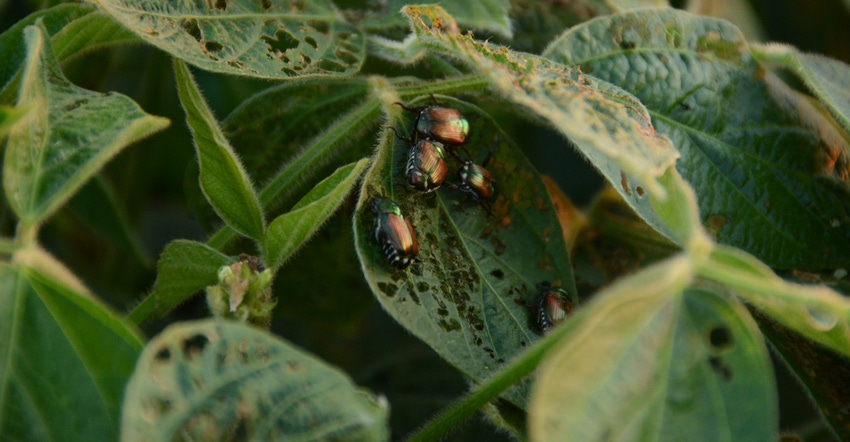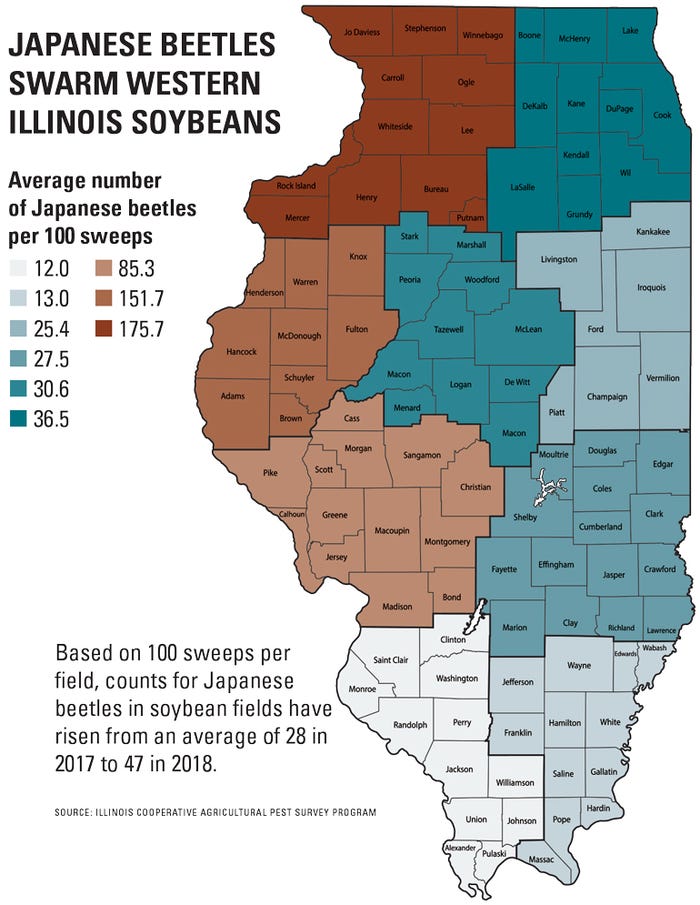
As pest survey coordinator Kelly Estes caught insects and talked with growers this season, Japanese beetles filled both nets and conversation.
The recently finalized Cooperative Agriculture Pest Survey affirms what many Illinois farmers observed: the Japanese beetle is the most prevalent insect pest for Illinois in 2018. An average of 47 were caught statewide per 100 sweeps in each surveyed soybean field, compared with 28 in 2017 and 16 in 2016. Every region in the state experienced an increase.
“Japanese beetle populations tend to be cyclic. They build slowly in an area, peak, and then you see a decline,” Estes says. “They overwinter in the soil, and so when we start getting these really cold winters or deep freezes, the question always comes: Is it cold enough to kill them?”

Drought conditions in early summer also hold potential to reduce Japanese beetle populations. But Golden Harvest agronomist Stephanie Porter says there are more proactive measures farmers can take than waiting on weather.
The regions of western Illinois she covers were shown to have the highest average number of Japanese beetles in the survey, so she advises farmers to spread their risk with corn varieties that mature at different times. Japanese beetles eat corn silk and move onto soybeans once corn matures.
“A lot of growers like my dad will plant three different maturities on his farm. He didn’t used to,” Porter says. “But a lot of them do that in western Illinois, where they’ll do a 109-day, a 112- or 113-, and then up to a 118-day.”
She also advises growers to plant earlier if the soil conditions are right, as Japanese beetle populations are higher in corn that’s planted late.
Defoliation and soybeans
Soybean plants are well-known for their ability to sustain a large amount of damage to leaves without much of an impact to yield. Because of this, Porter says defoliation with soybeans can often be an afterthought — but eventually, the bites add up.
“I know the damage can look worse than it is, but it was that bad in western Illinois on soybeans,” Porter says. “The Japanese beetles have a longer time to feed on soybeans than they do corn. And there’s other insects that are doing defoliation as well, so it’s kind of a compound effect.”
Estes reports she saw an abundance of green clover worm and loopers across the state, and while those pests aren’t often treated as a threat worth upping insecticide treatments, they’re having a combined effect with Japanese beetles.
“In western Illinois, I think it’s really paid to use an insecticide with the fungicides they’re using to get their high-yield soybean crop,” Porter says.
Western corn rootworm
While the Japanese beetle is taking the spotlight for 2018, the western corn rootworm is still a cause of concern for many Illinois farmers.
Populations on average are low, according to the survey, but Estes reports finding a few fields that were swarmed by the pest.
“You will see fields with no western corn rootworms, and then you go 5 to 10 miles down, and you run into a field where there’s a lot of them,” Estes says.
In the survey, there was a small uptick in corn rootworm for western Illinois, but not over the whole state.
“I’m seeing that uptick,” Porter concludes.
About the Author(s)
You May Also Like




